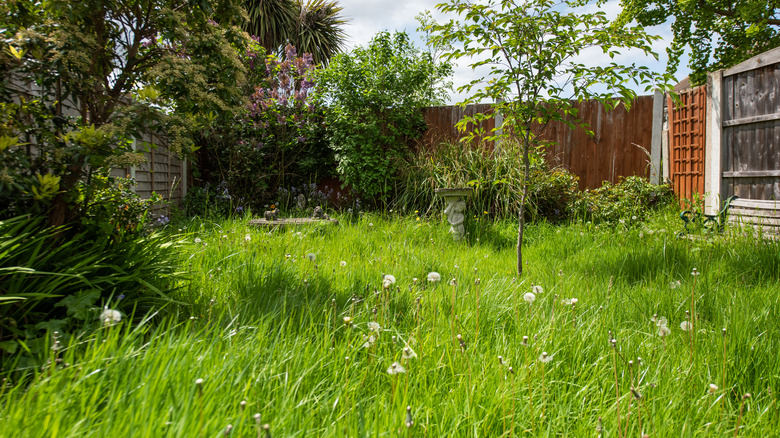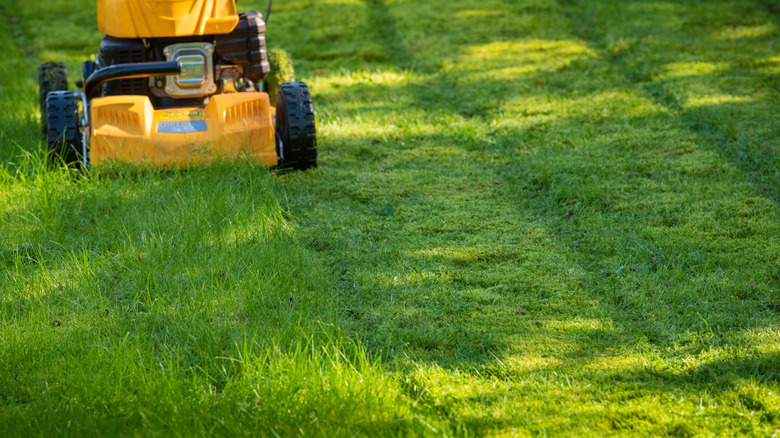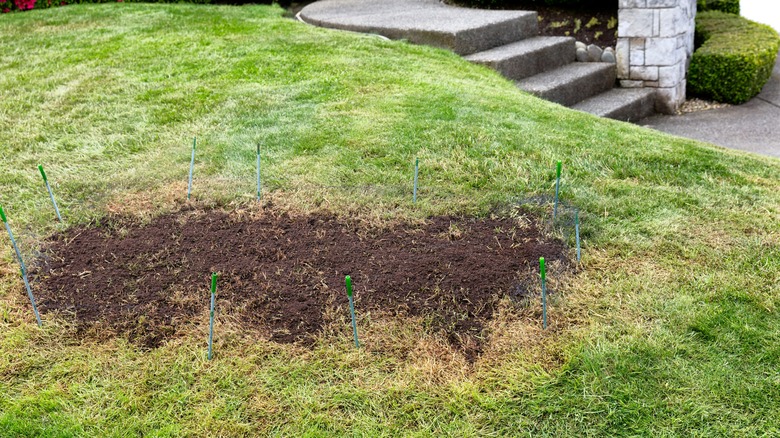The Drawbacks To Planting Fast-Growing Annual Ryegrass Seed
We may receive a commission on purchases made from links.
If you're after a backyard you're happy to spend time in, knowing which grasses you should plant for a lush, green lawn and which should be avoided makes all the difference. One of the grasses in the latter category is — in almost all cases, at least — annual ryegrass. Farmers grow it as a cover crop and, in residential and landscaping settings, it's used as turf grass in lawn seed mixes or on its own. It's liked because it grows fast, survives moderate winter temperatures (sometimes called "winter grass" because of this trait), has a deep root system that breaks up the soil and provides nutrients when cut back, and doesn't mind being stepped on. Annual ryegrass (Lolium multiflorum) is also one of the cheapest grass seeds, making it a seemingly attractive option for homeowners on a budget.
Annual ryegrass — also known as Italian, common, winter, domestic, and Oregon ryegrass — is typically used for overseeding dormant warm-season grasses, and this, coupled with all the aforementioned positive features, can perhaps account for why the species is so often included in low-cost, so-called all-purpose turf seed mixes like Canada grass. This southern European native plant has, however, some potentially deal-breaking downsides. It should come as no surprise, given the name, that annual ryegrass lasts just a year before dying back. It's also less visually attractive and has higher maintenance than other turfgrasses, requiring more mowing and frequent watering. It's a bit temperamental, too, succumbing rather easily to everything from frost to powdery mildew.
Annual ryegrass is a high maintenance lawn plant
It's in the name: Annual ryegrass is a temporary lawn solution at best. You need to replant it year after year, and you have to carefully consider where and when you're planting it. The species dislikes climate extremes and will go dormant if the thermometer drops below 50 degrees Fahrenheit or rises above 90. Despite annual ryegrass being a cool season plant, it can suffer winter dieback in the northern U.S. It does, however, need lots of sun to thrive, at least six to eight hours a day. It's not the best kind of lawn for shady backyards. Conversely, it's also far from drought-hardy.
You need to mow this grass frequently; it grows quickly, reaching 2.5 inches under optimal conditions. It also grows in clumps so pushing a mower through a thriving annual ryegrass lawn and keeping it looking uniform can be a challenge. Planting it at the right time is vital for good growth — that is, in September or November, depending on where you live. Seed an annual ryegrass lawn too late and the resulting seedlings might not be strong enough to survive a cold winter. This species of turfgrass is also more susceptible to certain diseases, like stem rust, powdery mildew, leaf spot, and brown patch, than its counterparts. Armyworms and beet armyworms like to munch on its leaves. All this is, perhaps, surprising considering annual ryegrass' aforementioned popularity in budget lawn seed mixes.
Use annual ryegrass to stabilize slopes and cover bare patches
The grass boasts coarse blades and is a rather unattractive lime green. Annual ryegrass isn't even that good at the things you may actually want to use a fast-growing grass for. It reduces growth in other, more popular turf grasses like Bermudagrass, making it problematic as a winter placeholder lawn grass, and doesn't spread by rhizomes or stolons, meaning it won't spread to fill in gaps in patchy turf. Annual ryegrass is also fast becoming a weed in parts of the U.S. where it's used as a cover crop due to its rapid growth and ready seeding.
Is there any reason to use annual ryegrass? It's good for stabilizing a bank or slope or quickly covering a bare batch before spring sowing. There are some new cultivars that look and perform better. A sack of Pennington Annual Ryegrass seed is cultivated to be more drought, heat, and disease-resistant. A 10-pound bag costs less than $30 at Walmart. Or get a 50-pound bag of Super Overseed brand Panterra turfgrass seed for $86.25 from Johnston Seed Co. If you want to avoid annual ryegrass altogether, substitute perennial ryegrass or invest in different types of grass seed — for example, a premium turfgrass mix suitable for your region. Always check the back of a seed mix pack, especially if it's an affordable mix, for annual ryegrass, and put the bag back on the shelf if you find it.


